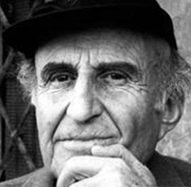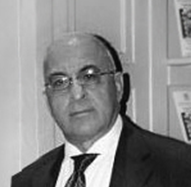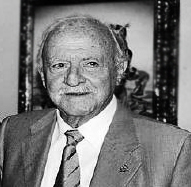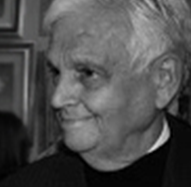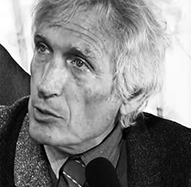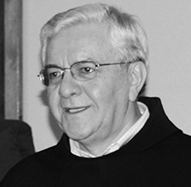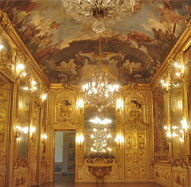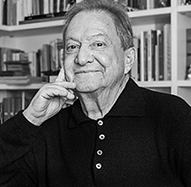
«Contemporary art has no rules. (...) Nevertheless, in bewilderment demeaning of artistic and cultural life, there are artists who love, as always, freedom and respect the fundamental rule of communication. The ability to be understood by the legitimate users and to offer education to good, the beautiful, the honest. Concetta Cormio, poet who does painting, a painter who does poetry is one of them. In her there are simplicity, linearity, color, emotion and her garden that respects the seasons.»Continue to read
Criticism and Press review
Manlio Cancogni
Concetta Maria Cormio lives in Milan, but she’s particularly attracted by the landscape of Tuscany, the Maremma, the Marsh of Bientina. She paints hills, farmhouses, but also faces of saints and madonnas with an exaltation detail of light. Concetta Maria Cormio is a talented painter.
Manlio Cancogni
Carlo Franza
'The milanese artist Concetta Maria Cormio has been active for years in the Italian art scene, without ever resorting the avant-gardes and the news of the moment. If anything, she always insists into big figural line that has found different developments, from Existential Realism to New Figuration, up to the ramification of a contemporary neo-romanticism, which is able to shake the hearts and specially to give back voice to an alive past.
So she vividly tells us courtly themes, expressing signs of beauty in the feminine, through portraits of weight and style, arguing dreams full of symbols, and giving mirror to the nature and to Italian landscapes with an eye on everything Franciscan. Cormio is masterly in vividly telling and describing memories, states of intimacy collected in those tones between pink and orange-yellow that extend her palette.
She is a rigorous artist drawer, an excellent colorist, a poetess who is as able as a few to read the landscape and to transfigure and give it than trough a game of lights, trough that peace and that serenity, which are today precious goods among the painters who no longer seek the real beauty, the property and the real pearl of the heart.'
'With a simple and mature sensibility, though strong and Francescan, united to a culture full of laic and spiritual moods, the Milanese artist Concetta Maria Cormio lived for years her pictorial career in the Italian artistic survey with vividly ignitions and a motivation that let immediately read the point of an artist aimed at education. And in a possible story about Italian painting landscape there is a golden place for her too, next to the names that everybody knows, from Domenico Purificato to Vincenzo Ciardo.
Cormio scenically dusts hills and plains, farmhouses and country houses, and pocket handkerchief plots with sometimes solitary trees, real watchmen in the silent landscape surrounding them. Everything is dig up with a polished color, among embroideries of green, orange foliage, blue skies, iconic pieces of a contemporary neo-romanticism that on several occasions and in many parts of the world, from USA to Italy, escapes wrapping the entire poetic of a lot of contemporary artists. She measures herself on classical themes of neofiguration, even if they are innervated to contemporary, that is by images of female monochromatic faces, up to silent David Hocney's landscapes.
By one side she’s a meditative and Franciscan painter, when she tells with pale pastels memories and moods, on the other side she’s feverish and daring if the palette is covered of bright colors. But her painting feeds on, and vice versa, that feeling exuding from her being also a poetess, that talking from the heart, that symbolizing Pascoli’s scenes too, memories and philosophies of seasons, insatiable references to beauty, and that fixing a new colored canticle of creatures.
Carlo Franza
Raffaello Bertoli
In her representations there are always dream, enchantment, abstraction. Concetta Maria Cormio was born in Milan from a Tuscan mother and an Apulian father. She lives and works in Milan. She’s got a house at Torre del Lago, which was Giacomo Puccini’s active retirement and is interested in particular in the Tuscan landscape: Versilia, Maremma, white hills along the Emilia way, vineyards and olive groves of Montecarlo, the marsh of Bientina, sceneries of the Apuane.
She makes Saints, Madonnas, Saint Chiara, Saint Francesco, Tuscan peasantries, Milanese common people, girls of Versilia.
In all, overall – faces and landscapes – the exaltation of light, the attention to what is behind everything.
Primitivism, also the modern, is simplicity, interiority.
Concetta Maria Cormio draws on the art of 13th Century and of the 14th Century, on Cimabue, on Duccio, on Giotto.
She feels L’Expressionism of 20th Century, expecially the Lombard Chiarismo. Semplicity, brightness and clarity are the fundamental components of Concetta Maria Cormio’s painting.
Abstraction and enchantment arise spontaneously; they are squatting on the bottom of inspiration.
What we can see in saints’ faces we see in the landscapes. It’s the same light which illuminates the whole and irradiates in the whole.
I add that in her verse there are the same essential components, whereby the operating of this clear artist results an homogeneous ensemble.
Raffaello Bertoli
Tommaso Paloscia
Round hills which emerge as virginal breasts on the far horizon to circumscribe the surreal milky flood that, darkness not yet dissolved by the sun, imprisons fields almost swallowing the cottage: a village all packed in defense of its bell tower. It is an inundation of light, that allows the sky, semitransparent in the subtle and light cloud, to looks at oneself in that sky of silence and of solidified light.
Immense slab of marble slightly veined as we can find in the quarries of Carrara. And the image looks like emerging for magic solicitation from that panoramic sight of the lake of Massaciuccoli, painted the year before by fantasy and by Concetta Maria Cormio-s estrus, exactly in 2001.
And if the day goes on, in the beautiful season, and the layer disappears by magic revealing the beauty of nature, capriciously captures and removed from the view, the Tuscan countryside springs to the fore with the intriguing intrusiveness of pines and cypress, that are the ornamental patterns of this land, which is very rich in suggestion.
And also when the very good artist’s attention focuses on a single flap of landscape, isolated not from the look but from the sentiment, in that expanse of wonders, also a lonely tree is able to sing its poetry. Which is in effect the poetry laying in her soul; a poetry that, in parallel with the painting, sings verses full of nostalgia the points passed in review among Versilia and Maremma. Always with the heart which surpasses the eye, in the finding mission among the images stored in the consciousness.
Concetta Maria Cormio, however, was not born in this region that she prefers to represent the landscape. She is Milanese, from an Apuleian father but from a Tuscan mother.
And it is maybe from here that the wellspring of predisposition to read with love the chaining of a lush and gentle countryside comes, its field that are green or flood of gold from sunflowers, which in the foreground offer the leaves and the flowers to the poetry reading of who knows what messages earnestly interpreted by Cormio‘s creativity in painting.
One of her poems says:
What a beautiful place:/ I’m fine./ The earth is warmed by the sun/ Trees, moved by the wind, / shadow. /Some white clouds/ and a deep peace. /A little more, /then I come back to the world. /Dear, old world/ come rainstorms, /take me to the edge/ of the life, the same, /over the oases warmed by the sun.
But tomorrow there will be another beautiful place to brighten the life and that this evening we already dream in the halflight. And we invoke it. 'Don’t turn in the soul/the light of the evening'; says the poetess. And the painter notes.
Tommaso Paloscia
Giorgio Falossi
A figurative painting, but unic, personal, the result of studies and sensitivity so that they find themselves in Maria Concetta Cormio. Color has the consistency of enamelled metal contained in a solid design and the areas, clearly demarcated from light, fix the image at its solid place. A quiver pushed by harmony lives in the landscapes carefully chosen with the effort from not only visual input but also from an her own inventive, accure to gestures, at the proportion and the perspective, despite the prevalence of skilled light distribution leading the work until an expressionist trend. So the fiery red sunsets and lagoons, meanwhile the white creeps in the valleys and in the drapery making memorial vision, imbued with one moving but proud, melancholic stupor. The artist, besides painting, writes poetrie, operates with strong creativity to direct, with lovable directing the flow of the sensations to result in a very visual work compost color harmonies. The artist choose certain intimacy that she considerated beauties, a world that she still feel home of common passions and human hopes. And a burning desire for peace. A pictorial theme regards man and his consciousness, regards the nature and the territory. Reflects the atmosphere of the time to dream about the harmony of nature against the stress of daily life, concerns also the nourishment of the spirit in a period when the West has the crisis of its christian values. Relating the man who has gone beyond the exploitation for profit's sake and the whole work of Maria Concetta Cormio can take place between the anxiety of the present and the variety of nature, between the intelligence and the tradition. This Cormiana’painting has hidden truth, but not hidden artistic by artistc resolutions that became instument, who wants listen it, of foresight and great beauty.
Giorgio Falossi
Manrico Testi
Figurative painting with prevalence of the nature, very carefully to the lights and colors, the sure sign brings the love of nature that the artist deliberately conveys in the landscapes with chromatic softness. These pictorial achievements are obtained, beyond the technical mastery, with experience of an artistic language such that to meet the expression needs, in a painting that became impressionist where it has already found an identity, a personal tone and also a figurative magnitude.
Manrico Testi
Massimo Baldini
The man of electronic galaxy lives in the size of noise and gossip. He often speaks just because he wants to speak and says trivial things. 'Bavarder – wrote Maurice Blanchot – est la honte du langage'. Gossip is a dishonor, the shame of language because it’s a speech without importance, it makes noises not sounds. Today, speaking and writing are only made by the use of someone’s mouth or hand without using the brain. So, most of the people use a lot of set expressions, like a disposable Kleenex, because language has become an empty case.
Only poets and mystics, lovers and children can still use language in a creative way. They use words in a playful and dissolute way and this lead them to new discoveries in the reign of words. In fact, as John Wisdom writes, discoveries are made ' not only by scientists with a microscope, but also by poets, prophets and painters'.
Today silence moments become always fewer. Our life is a gallery with Geena noises and gossips. Man has become, to say it as Picard, 'an appendage of the noise'.
But poet’s words has to be a word that has its soul in the silence. De vigny talked about poetry as an art silencieux, Rimbaud was proud of himself because he was a maître du silence, Mallarmè a musician du silence, for Claudel, the poet had to be a semeur de silences. The way in which the poets speaks, wrote Heidegger, is 'the listening of the silence'. The poet doesn’t like words that are like 'dead shells', he needs words that were born by the silence of words 'above the stars and flood by the sea'. Poet can use the silence. Poetry, wrote Picard, 'was born in the silence and misses the silence'.
Even for Concetta Cormio silence has a fascinating power, it is not common. In fact it is the leit motiv of many of her poems. Sometimes, she writes, 'silence creates hearts games', but silence also picks the flowers of love'. She loves silence that 'becomes a word', the silence that 'composes eternal music' and her pen 'picks silence words'.
If there’s a red line that can link, implicitly or explicitly, all of her poems this red line it the theme of silence. Joe Bousquet said that writing for a poet is the same as translating the book of the silence and this is what Concetta Maria Cormio tried to do writing about poetry.
Massimo Baldini
Carlo Franza
Concetta Maria Cormio's poetry themes are firstly based on attentions to reality and sudden landscape strokes, as if nature told by vaporous first impressions would let discover a landscape soaked with transparent gloss; but also firmly rise the spontaneity of the living, the anxiety of life, the constance of human presence, poetry that become thought, memory, conversation, soliloquy.
The poet, half Lombard and half Tuscan, even revealing her religious involvement on the quiet ('...when life goes / beyond death / meets God.'), contemplates not only the rural world of her origins, to such an extent that her voice contemplates the intact dream of a peasant childhood ('...I remember sunny fields / cicadas singing / intense perfumes...'), but entrust to word her joyful state, her private human suffering.
Sometimes, however, the love for life drops to a whisper, to a musical breath, to the astonishment of being alive, to a shudder of the mind, to a sober and transparent emotion which slippers on herself like a perennial rain, between agonizing memories, illusions and beloved ghosts who throw their farewell to life ('...I write with the pen / of the past / memories and illusions...'). Every line is an escape, a melody, an unrepeatable and melancholy grace.
Neo-crepuscolarism and Neo-romanticism weave lines and words, since poetic voice is permeated by a feeling of chaste loneliness, by the abandonement to her own ghosts, by the trust in eternity, by the conversations with her beloved ones, as much as the lyric tension is sometimes measured by the breath of the voice itself ('...My heart seeks the strenght / and my pen / raises silent words....'). Poetries are also a seamless diary of adventures, encounters and sharp memories, and elusive portraits are always faces that have names in her private sphere.
Autobiographical tone digs a truth that translates the inner pursuit,from which a feeling of inebriation can never be disrupted, the powerful yearning of life, where lyrical ecstasy is sublimed by a full and pleased sentimental address.
Concetta Maria Cormio's poetry has a concerned timbre of a powerful voice and it's discernible in sounds, recurring words, melodic pattern, and rhymes, so it renders to be cloncluded and exact music.
Emotions which came from encounters and memories, moments of sadness and joy, city and countryside, unripe spring and odours of autumn, wandering, dizziness of sensations, link between the existance and people, proportions between nature and I itself, everything lead the poet to that strange will to live, to what poetry hold in its breath. Here is 'Il profumo dei ricordi' ('The Perfume of Memories') groups senses and human motion, arias and themes where accounting and melodic game chase the lines, bringing the feeling to undress itself from surreality.
In Concetta Maria Cormio's poetry, visibility of the word finds one of the most passionate celebration in contemporary lyric, and the colour and the repetitiveness of some keywords assign to her bold poem the volume of a rich autobiographical substance.
Carlo Franza
Padre Luciano Bertazzo
I know about Concetta Cormio just for some phone talks, for her poetry and for her paintings, which express unexpected spaces in willowy brushstrokes. So may seem not consistent that she asked me for a presentation about her new poetry book. May seem. But perhaps it could be less obvious than it sounds, if we just are ready to listen what she offers us, her way of telling about herself through poetry. Words that emerge from an inner need; words that can build architectures upon answers, perceptions and concerns which have always been in our souls.
The poet is a pilgrim, traveler on the path of everyday prose, able to transcend it in the beyond of poetry.
And as for any human being, even in Concetta Cormio everyday there is morning and evening, there is a home, there are friends, there are some questions for her sons, melancholy and some big questions about the meaning of life.
The poet is a pilgrim, every day nibbling the taste of silence, which is capable of feeding the word. Silence is the condition to express essential words: 'I immerse myself in the silence', 'in the silence of eternal music', 'Be the new day a silent chant'.
The poet is a pilgrim, every day along the trying path of complexity he is in the entering harbor of simplicity, capable of wonder, and of a fruitful silence inhabited by words. Pilgrim in time, traveler to the Eternal: 'Could life dissolve / and finally could I meet God'.
And we all are travelers. Awareness of being this way makes a difference: between restless, bitter meandering and a pilgrimage stroking, step by step, 'our mother earth' and its being.
The collection Concetta offers to us is made richer by the images of her paintings. They speak us about a motionless silence. They tell us about a metaphysical space. They offer us a brightness which is not only from the sun.
For her this is repeating what the poetic word had already expressed, through a different, but not less amazed expressive code. A meeting of languages with the only need to give voice and color to what is in the traveler saddlebag.
We should be grateful to poets, because they care capable to give voice to what is inside us; because they give us words which, macerated by the power of silence, mature in beauty.
And together with them, less lonely, we should go in the prose of live.
Padre Luciano Bertazzo
Award of Culture and Arts of Milan
« With verses where the word becomes tinge of reality and the result of artisan wisdom, Cormio offers readers picked the very breath of poetry »
Download the award’s poster
From this page you can download some articles Concetta Maria Cormio
